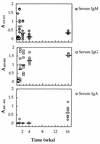Immune responses of specific-pathogen-free mice to chronic Helicobacter pylori (strain SS1) infection
- PMID: 9529052
- PMCID: PMC108059
- DOI: 10.1128/IAI.66.4.1349-1355.1998
Immune responses of specific-pathogen-free mice to chronic Helicobacter pylori (strain SS1) infection
Abstract
A model permitting the establishment of persistent Helicobacter pylori infection in mice was recently described. To evaluate murine immune responses to H. pylori infection, specific-pathogen-free Swiss mice (n = 50) were intragastrically inoculated with 1.2 x 10(7) CFU of a mouse-adapted H. pylori isolate (strain SS1). Control animals (n = 10) received sterile broth medium alone. Animals were sacrificed at various times, from 3 days to 16 weeks postinoculation (p.i.). Quantitative culture of gastric tissue samples from inoculated mice demonstrated bacterial loads of 4.0 x 10(4) to 8 x 10(6) CFU per g of tissue in the animals. Infected mice had H. pylori-specific immunoglobulin M (IgM) and IgG antibodies in serum (at day 3 p.i.) and IgG and IgA antibodies in their gastric contents (weeks 4 and 16 p.i.) and saliva (week 16 p.i.). Mucosal IgM antibodies were not detected. Histological examination of the gastric mucosae from control and infected mice revealed mild chronic gastritis, characterized by the presence of polymorphoneutrophil cell infiltrates and submucosal lymphoid aggregates, in infected animals at 16 weeks p.i. Differences in the quantities of IgG1 and IgG2a subclass antibodies detected in the sera of mouse strains (Swiss, BALB/c, and C57BL/6) infected by H. pylori suggested that host factors influence the immune responses induced against this bacterium in the host. In conclusion, immune responses to H. pylori infection in mice, like those in chronically infected humans, appear to be ineffective in resolving the infection.
Figures







References
-
- Atherton J C, Tham K T, Peek R M, Jr, Cover T L, Blaser M J. Density of Helicobacter pylori infection in vivo as assessed by quantitative culture and histology. J Infect Dis. 1996;174:552–556. - PubMed
-
- Blanchard T G, Nedrud J G, Czinn S J. Qualitative and quantitative differences in the local immune response to Helicobacter in mice and humans following immunization or infection. Gastroenterology. 1996;110:A867.
-
- Callard R E, Gearing A J H. The cytokine facts book. London, United Kingdom: Academic Press; 1994.
-
- Crabtree, J. E. 1993. Mucosal immune responses to Helicobacter pylori. Eur. J. Gastroenterol. Hepatol. 5(Suppl. 2):S30–S32.
Publication types
MeSH terms
Substances
LinkOut - more resources
Full Text Sources
Other Literature Sources
Medical
Miscellaneous

